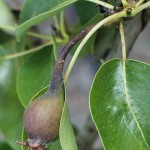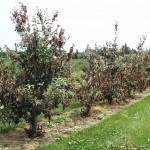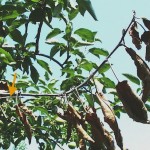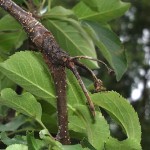Wednesday, 28 May 2014: The first fire blight symptoms are now appearing in Hudson Valley orchards. Dying blossom clusters or shoots noted while spraying orchards should be investigated carefully to determine if fire blight is causing the die-back. Early evidence of the blossom blight includes blackening of small fruitlets (or the remnants of flowers), with the black discoloration extending down the flower stem. Tiny droplets of ooze are often evident on the surface of the blackened tissue during the early phases of infection. Within a few days, leaves on subtending spurs and/or bourse shoots usually develop blackened veins and shoot tips droop into the traditional shepherd’s crook that is a classic symptom of fire blight infections. We had enough heat units during bloom this year to trigger fire blight even on some of the more resistant cultivars such as Empire. Therefore, check all cultivars carefully, especially if you only applied strep to the most blight-susceptible cultivars. Photos below from previous years show the range of symptoms that can be expected.
- Early stages of blossom blight on apple with blackened fruitlet stem
- Bacterial ooze on pear stem with original blighted blossom at the base of the stem (arrow)
- Blossom blight in advanced stages
- Blossom blight on quince showing initial necrosis of leaves (upper right)
- Shoot killed by fire blight and showing classic “shepherd’s crook” symptom
- Apple tree damage created by blossom blight infections
Newly planted trees with flowers opening this week are still at high risk for fire blight infections and should have been treated with streptomycin or strep-plus-copper on Monday or Tuesday. They may need a second treatment today or tomorrow if additional flowers are still opening because both strep and copper can protect only those flowers that are open when the spray is applied. I suggest using the combination of strep-plus-copper on newly planted trees because strep will be far more effective than copper for protecting blossoms so long as there are no strep resistant strains (which so far have not been detected in the Hudson Valley). Adding a low rate of copper with the strep will provide some protection in the event that strep-resistant fire blight was present in the trees you purchased this spring. Getting free fire blight via nursery stock is not a common event, but it can happen.
If newly planted trees come down with fire blight, and especially if any newly planted trees appear to have root stock blight (i.e., dying tissue and/or oozing on the rootstocks), the diseased trees should be removed immediately so as to prevent further spread. New York growers who find fire blight in young trees are encouraged to send a sample to Dr. Kerik Cox at the Geneva Experiment Station so that it can be tested for strep-resistance. Do not allow samples to dry out. Keep them refrigerated prior to shipping, ship via over-night service, avoid Friday shipments, and be certain that the sample includes the canker margins. The latter is best accomplished by ensuring that any shoot selected as a sample has both healthy and dying leaves still attached to the sample. Fire blight from older trees may also be sent to Geneva for resistance testing if there is reason to believe that well-timed strep sprays failed to control the disease. Samples should be accompanied by a data sheet that tells the location where the sample was collected (GPS coordinates if possible), the cultivar and rootstock, the age of the trees, dates that strep was applied this year, and (for young trees) the nursery source.
Some folks choose to eliminate fruitlets on newly planted trees by pinching out the flowers during bloom, but that activity can also spread fire blight if inoculum is present on the trees. Because hot humid weather favors fire blight, flower pinching should be done only after a strep spray has been applied to kill off any surface inoculum, and no pinching should be done when trees are wet from rain or dew. The latter caution applies to any pinching or fruit removal in young trees over the next few weeks.
If fire blight infections become evident, infected shoots should be removed immediately unless the numbers of infections make removal unfeasible (e.g., in larger trees with many strikes per tree). In pears and in apple trees less than five years old, one must always remove strikes as they appear to avoid losing entire trees and to limit the amount of inoculum that those infections will produce if they are not removed. If infections are limited to just a small group of trees in one location within an orchard, then those trees should be completely removed so as to eliminate the inoculum source. On older trees with numerous infections, the cost of removing infections and scouting the orchard twice per week for the next few weeks may be prohibitive. In such cases, it may be best to allow fire blight to run its natural course and then decide in the fall if the orchard is salvageable. However, allowing blight to run its course without removing strikes means that those infected trees may act as an inoculum source for other nearby plantings until at least mid-summer. Given all of the potentially competing considerations, decisions on how to deal with fire blight after it appears in orchards must be made on a case-by-case basis.
Where fire blight is present in an orchard or an adjacent orchard, violent thunderstorms and/or hailstorms can create visible and/or microscopic wounds that allow entry by the blight bacterium. Wind and rain can rapidly spread inoculum across large acreages. Streptomycin should be applied within 24 hours of any hail event or severe windstorm if there is fire blight evident in the orchard or within a half-mile up-wind from the orchard in question. The next few weeks pose the greatest risks for hail-exacerbated fire blight because blossom infections will be producing an abundance of inoculum and shoots are still extremely susceptible to infection if that inoculum is blown around during storms. Trees become resistant to fire blight when terminal shoots stop growing, so there is generally no need for strep applications during the preharvest intervals noted on the product labels.
Finally, there are several things that can be easily confused with fire blight but that are of much less concern. First, some shoots may be dying right now in Hudson Valley orchards due to secondary fungal pathogens that invaded cicada egg-laying scars that were created last year by the 17-year cicada. Second, some orchards may have shoots that are dying from Nectria twig blight (see photos below). The latter is most common on Rome trees, but it can occur on other cultivars as well. Nectria infections can usually be traced back along the twig or branch to a fruit cluster base from last year where fruit stems were left attached to the tree during harvest (i.e, the stems pulled out of the fruit). Those pulled stems provide a common entry point for Nectria cinnabarina. Eventually, infected fruit cluster bases will develop the orange-pink fruiting structures typical of N. cinnabarina. The canker rarely extends back into larger limbs from these initial infection points, but all of the new growth beyond the infection points will eventually die, causing symptoms that resemble shoot blight caused by the fire blight pathogen. Unlike the case with fire blight, Nectria infections can be ignored for the moment and then removed either during summer pruning or when pruning next winter.
- Apple shoot killed by Nectria canker originating from infection via pulled fruit stems (arrows)
- Nectria twig canker in June originating from a pulled stem
- Nectria twig canker in late summer showing orange fungal fruiting structures









